Access to highly active Ni–Pd bimetallic nanoparticle catalysts for C–C coupling reactions†
Abstract
Bimetallic Ni–Pd alloy nanoparticles with high Ni to Pd atomic ratios (99 : 1 or 95 : 5) were prepared, and the catalytic performances of these nanoparticle catalysts were explored for C–C coupling reactions (Suzuki–Miyaura, Heck and Sonogashira reactions) under moderate reaction conditions. In contrast to their monometallic counterparts, significantly enhanced catalytic activity was achieved with the studied Ni–Pd nanoparticle catalysts for the C–C coupling reactions, and products were obtained in moderate to high yields. The turnover number (TON) increases with the increase in the Ni to Pd atomic ratio for Ni–Pd nanoparticle catalysts and can reach 3.6 × 103 for Ni0.99Pd0.01 nanoparticle catalysed Suzuki–Miyaura reaction of aryl bromides with arylboronic acid at 50 °C. Advantageously, such Ni–Pd nanoparticle catalysts with high Ni to Pd atomic ratios not only show significantly enhanced catalytic activity but are also stable (ICP-AES analysis showed only marginal or no Pd leaching) and retain their catalytic activities for several catalytic runs (>90% conversion even at the 7th catalytic run). Experimental and relevant theoretical calculations (net charge localization using first principles calculations) suggested a substantial Ni to Pd charge transfer which resulted in a highly negatively charged Pd centre, a favourable site for facile oxidative addition of aryl halides, and hence enhanced catalytic activity for Ni–Pd nanoparticle catalysts.


 Please wait while we load your content...
Please wait while we load your content...